Labrador exercise is a vital part of their daily care. Dog walks and visits to the park are beneficial, but there are lots of ways to keep your dog fit. Fetch, agility, tracking, hunting, swimming and even obedience training will burn calories, raise their metabolic rate, encourage cardiovascular health and maintain high energy output levels. And a good Labrador exercise routine will help you to stay on the right path for full fitness.
Contents
- The benefits of Labrador exercise
- Walking vs playing fetch
- Exercising through recall training
- Getting fit together
You should exercise your Labrador for at least an hour a day. Sprinting sessions can be shorter, but if it’s just a hike you’re going on then don’t scrimp on that time. It isn’t the exact quantity of exercise your dog gets on any given day that counts, but how much he gets on a daily average over time. Not only that, but there are some dogs that will actually benefit from less walking, or from different types of Labrador exercise. And there some that don’t need much formal exercise at all.
Why Labradors Need Exercise
Just like us, Labradors have a cardiovascular system (heart and blood vessels) that becomes more efficient and healthy, the more it is used.
Exercise literally helps your dog to grow more blood vessels and more effectively oxygenate his body.
Exercising helps build muscle and strengthen your dog’s bones. It protects him against injury and it increases his potential lifespan.
To a certain extent, Labrador exercise may also help with weight control. Although, like us, dogs are very efficient converters of energy. This means that reducing food quantities will be a more significant factor in keeping your dog slim.
The Benefits And Limitations Of Walking
Walking is good steady Labrador exercise. It doesn’t put too much strain on your dog’s joints. And if he is off leash and trotting at his own speed, it gets his heart and lungs working moderately.
If you like to jog or run, so much the better, provided that you build up distances and speeds gradually. Running will keep up sufficient pace for your dog to get a workout too.
If however, you have to walk your dog on leash, at your walking pace, he isn’t getting much of a workout.
So you’ll also need to put aside some time to get his heart pounding by raising the pace with some games or activities.
Labrador Exercise Methods
People often associate exercising the dog with going for walks.
It is however entirely possible to exercise your dog effectively without ever taking him for a walk in the traditional sense.
Retriever Training for Labrador Exercise
Most of my own dogs get the vast majority of their exercise through retriever training. They are working gun dogs and burn up masses of energy completing the varied and complex retrieves I set up for them.
You don’t have to be involved in shooting or hunting to get involved in retriever training. You can teach your dog to retrieve, no matter where you live or what your interests are.
The importance of fetch
Do teach your dog to retrieve. He is not called the Labrador Retriever for nothing. Retrieving is the perfect exercise for your Lab and one of the most helpful things you can do for any Labrador is teach him to fetch a ball or a retrieving dummy.
Retrieving is also one of the most effective ways to exercise any dog under control. It is especially important to do this, if you are not a keen walker or jogger, as it means you will still be able to give your dog exercise every day.
Dog Games And Toys
You can also exercise your dog very effectively in quite a small yard or garden with games. Try playing tug, or games with a flirt pole with a toy on the end.
Variations on fetch, or chasing games, using toys, balls, and frisbees are also great exercise for dogs.
Play Between Dogs Is Exercise
Two young dogs playing together for half an hour will give themselves a great workout. Not all adult dogs enjoy playing but many do.
My two Labradors are three and eight years old, and play together for at least half an hour most days.
If you have a friend with a dog that your dog will play with, do take the opportunity to get together when you can.
Your dog will benefit from the companionship of playing as well as the strength building and cardiovascular effects of play.
Recall Games For Dogs
Recall games are another great way to exercise your dog if you have a helper. You’ll both need a whistle and some treats.
Stand quite close to one another and call the dog back and forward between you.
Each time the dog sets off towards your partner, back away a few steps so that the distance between you is continually increasing. Get him or her to do the same.
Give the dog a treat every time to begin with and then intermittently once he gets into the game. If he has a favourite toy that he likes to run around with, you can also reward him with that.
Sprinting As Labrador Exercise
Recall and retrieving involve sprinting. Just as with any other sprinting exercise, build up distances and time spent sprinting, gradually.
Dogs really do benefit from sprinting, just as we do. It gets their hearts pumping and builds strength too.
Other Ways To Exercise Your Dog
So you see, if you hate walking, and don’t want to do it too often, or for too long, there are plenty of alternatives.
Fortunately, most of us enjoy a walk and the anticipation of shared walks is often the motivation for people to bring a dog into their lives.
If going for walks is your ‘thing’ that is just great.
Your dog will love accompanying you and will benefit from the company, the exercise and the mental stimulation of visiting new and interesting places.
How Many Walks Does My Dog Need?
If walking is your dog’s only access to exercise, if he has no other dogs to play with and you don’t engage him in any other activities, then a twice daily walk, with at least some of that time off leash, will keep him reasonably healthy.
Even if it doesn’t get him very fit in an athletic sense.
If you can only currently walk your dog once a day, then he will need some other activity at home too!
It is important to recognise that just because you have a large garden doesn’t mean your dog won’t need your company to get some exercise.
Dogs left outside in the yard on their own, don’t embark on an exercise programme, or expend much energy running around. A bit like people really!
Labrador Exercise By Distance
People often ask ‘how far should I walk my Labrador?’ or ‘how long should my walks be?’. These are difficult questions to answer. It depends a lot on what you are doing during those walks and on how active your dog is.
If he just walks alongside you, then you need to walk for a good hour and a half a day. Not necessarily all in one go. A brisk one hour walk takes most of us about three miles.
If you are punctuating your walks with lots of retrieves or some games or a swim, your dog won’t need to walk as far.
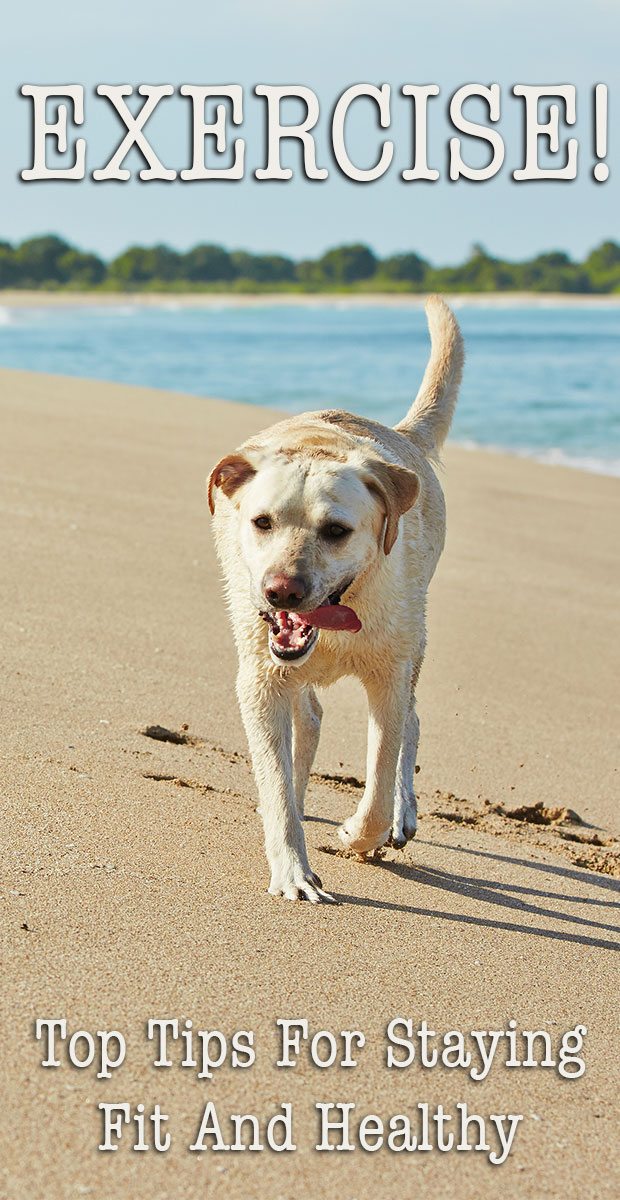
Think of it like this.
Your dog needs cardiovascular exercise just like you. Twenty minutes of hard exercise, where your dog gets out of breath and is running or swimming for much of the time, three or four times a week, will keep him fit.
Add another hour of gentler dog exercise each day and your Labrador will probably be a healthy, (and lucky) dog.
Of course walking is for both of you, and you’ll want to see the health benefits too.
Getting Fit Together – How A Pedometer Can Help
As a writer, I spend far too much time sitting on my backside. It is very easy for me to slide into bad habits when it comes to exercise.
So for several years now I have used a walking pedometer. To count how many steps I walk/run each day. And to make sure I don’t slip into ‘couch potato’ territory.
If you invest in a good pedometer you can keep a record of your steps. As a rough guide, three miles is about six thousand steps.
Many people find using a pedometer very motivating. I check mine at intervals, and if I haven’t walked a decent amount by the end of the working day, that is my cue for another jaunt in the evening.
Choosing a Pedometer
You can buy some very fancy pedometers now. But all you really need is a reliable step counter. If you are aiming for ten thousand steps a day, as many experts recommend, that’s okay for your dog too. As long as he or she is an adult Labrador in good health.
Provided you don’t walk in high temperatures or on very hard surfaces for long periods of time, he’ll be fine.
Getting Your Labrador Fit For Work Or Sports
If you intend to run long distance with your dog, or to work him on a shoot, or take him on hunting expeditions, you must get him fit first.
You should not just tip him in at the beginning of the shooting season, after a summer of sleeping on the lawn. He will simply injure himself the first time he jumps a wall or runs more than a hundred yards.
Remember that on a day’s shooting or hunting a dog may run twenty miles or more. Far more than his human companions are walking.
Preparing In Advance
Labradors are naturally fit and this won’t hurt your dog if you prepare him for it.
But a working retriever needs to be sprinting fit, not just walking fit. And that means building up retrieve distances gradually and adding in more challenging terrain gradually too.
A dog in this kind of training, probably won’t need walking at all, his training sessions will be sufficient.
Dog Exercise As A Form Of Behavioral Control
It is quite common to meet ‘experts’ who tell you to exercise your dog to the point of exhaustion in order to wear him out so that you can get ‘more control’ over him.
Before you dust down your roller blades, my personal view is that this is a very flawed strategy.
Unless you are a serious athlete it is unlikely that there is any level of exercise you can take your dog to, that will render him exhausted for very long.
Usually, the only outcome of intensively exercising a very naughty dog is an even fitter naughty dog.
We’ll look a bit more at control issues in a moment. But you may be interested to know that dogs don’t need to be exhausted or even tired to be trainable.
On the contrary, I train all my dogs ‘fresh’ not after exercise. That way I get all their speed and enthusiasm poured into what I want them to do.
A trainable dog does not have to be a slow dog, he just needs to be well motivated.
The Five Minute Rule Of Puppy Exercise
This would mean no more than 35 minutes of walking a day for a seven month old dog.
It is only fair to point out that this is just a guideline, and that it is quite an arbitrary one.
It’s not based on any kind of specific research or evidence, and was devised to help guide owners of small puppies rather than people with strapping ten month old dogs.
So a modicum of common sense needs to be applied.
Exercising Sick And Injured Dogs
Puppies are not the only dogs that may not benefit from long walks. Sick and injured dogs are often better off devoting their resources and energy to rest and recovery.
Often a dog will let you know when he is ready to get out and about again, but in some cases exercise will cause more harm than good.
You need to talk with your vet about your own dog’s exercise needs if he isn’t well, as every case is different.
Dogs In Pain
Labradors can be prone to painful joint conditions, especially as they age. There are some kinds of joint pain that respond well to exercise, once the stiffness wears off.
But exercise can, in other cases, make things much worse.
Again, it is really important to talk with your vet about walks if your dog finds them uncomfortable and is not keen to go with you. Sometimes, non weight bearing exercise, such as hydrotherapy, is more appropriate.
Pain medication can often help an arthritic dog recover his enjoyment of a daily walk.
The Aging Dog
In old age as well as in poor health some dogs may need a few minutes gentle lead walking a few times a day rather than the whole lot in one lump.
A very old dog may get to the point where he doesn’t want to go for a walk. It isn’t necessarily a good thing to force him to.
Have a chat with your veterinarian if you are not sure what your older dog’s exercise needs are.
Dogs That Have Started Chasing Wildlife
Labradors that have experienced the thrill of chasing deer, rabbits, or livestock such as sheep are at risk. They will often need a much more controlled programme of dog exercise in order to keep them fit and healthy while making sure they don’t get themselves into trouble.
If your dog has started chasing wildlife, don’t bury your head and hope that he will ‘grow out of it’. He won’t.
The problem will get worse. You need to start interacting with your dog out on walks, to get him more focused on you, and keep him closer to you.
You may also need to put him on a line and harness while you do some recall retraining. In the meantime, he will benefit from the range of alternative forms of exercise listed above.
How Much Exercise Does My Dog Need?
Walking is a wonderful daily ritual for many dogs and brings great pleasure and health benefits, but as we have seen it is not the only way to exercise a dog.
Dogs benefit from a range of different activities, that use different muscle groups and make their bodies work in different ways.
Try to make sure your dog has twenty minutes of aerobic (heart pumping, fast running) exercise most days.
And another hour of walking or an alternative exercise for dogs on top of that.
Variety is good, so if you spend an hour pounding the pavements one day, try playing games together in the backyard the next day.
If you don’t much like walking, mix it up! Your dog will be just as healthy as if he has a regular daily walk.
Adapt Your Dog’s Exercise As His Needs Change
Each Labrador is unique and his exercise requirements will change as he matures and ages.
Puppies need little structured exercise while mature Labs have a huge capacity for fitness and endurance.
Build your dog up gradually for work or competitions and don’t be afraid to let him rest for a few days if he is poorly, or stiff from over exercise.
And its okay to adapt your dog’s exercise as your own needs change too.
It is OK to rest your dog
A daily walk is great but does not need to be slavishly adhered to provided that the dog is getting a good amount of exercise and stimulation over the week as a whole.
If you are worried that your dog will quickly begin to physically decline if he doesn’t head for the hills each morning, think of all the dogs that have to have crate rest for weeks or even months after surgery or injury, and come to no harm from it.
It is OK to rest your dog for a day or two.
If you are not well, or are unable to go out, or if your dog is not well, it is ok to skip his walk.
The Labrador Site Founder
Pippa Mattinson is the best selling author of The Happy Puppy Handbook, the Labrador Handbook, Choosing The Perfect Puppy, and Total Recall.
She is also the founder of the Gundog Trust and the Dogsnet Online Training Program
Pippa's online training courses were launched in 2019 and you can find the latest course dates on the Dogsnet website

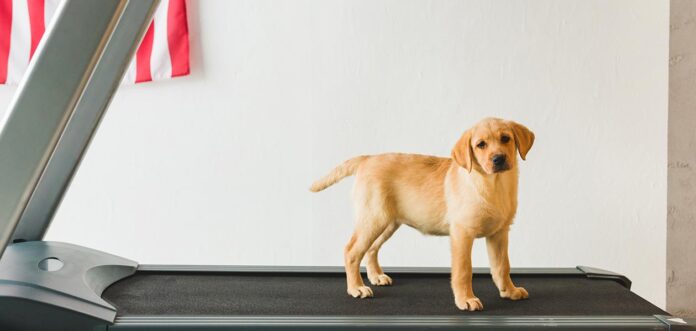
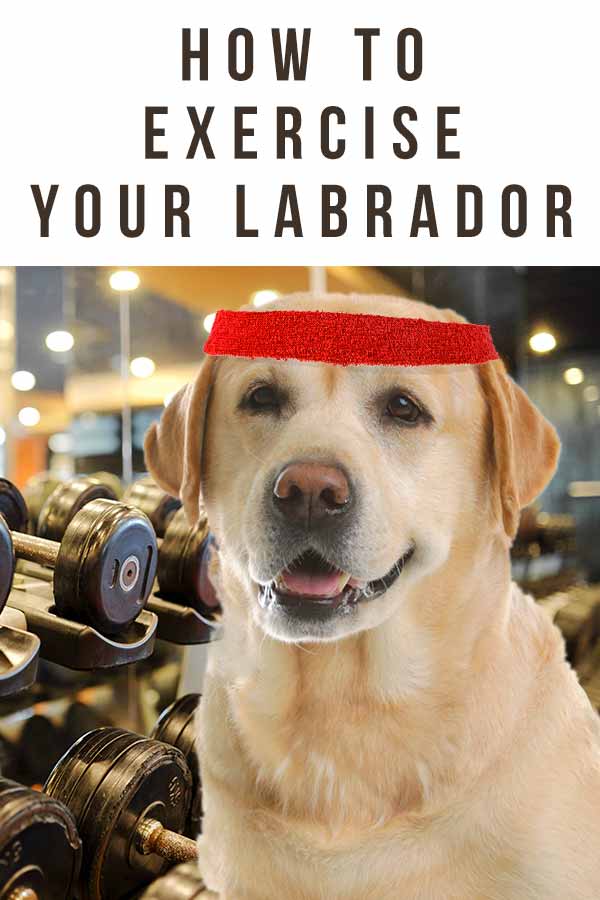
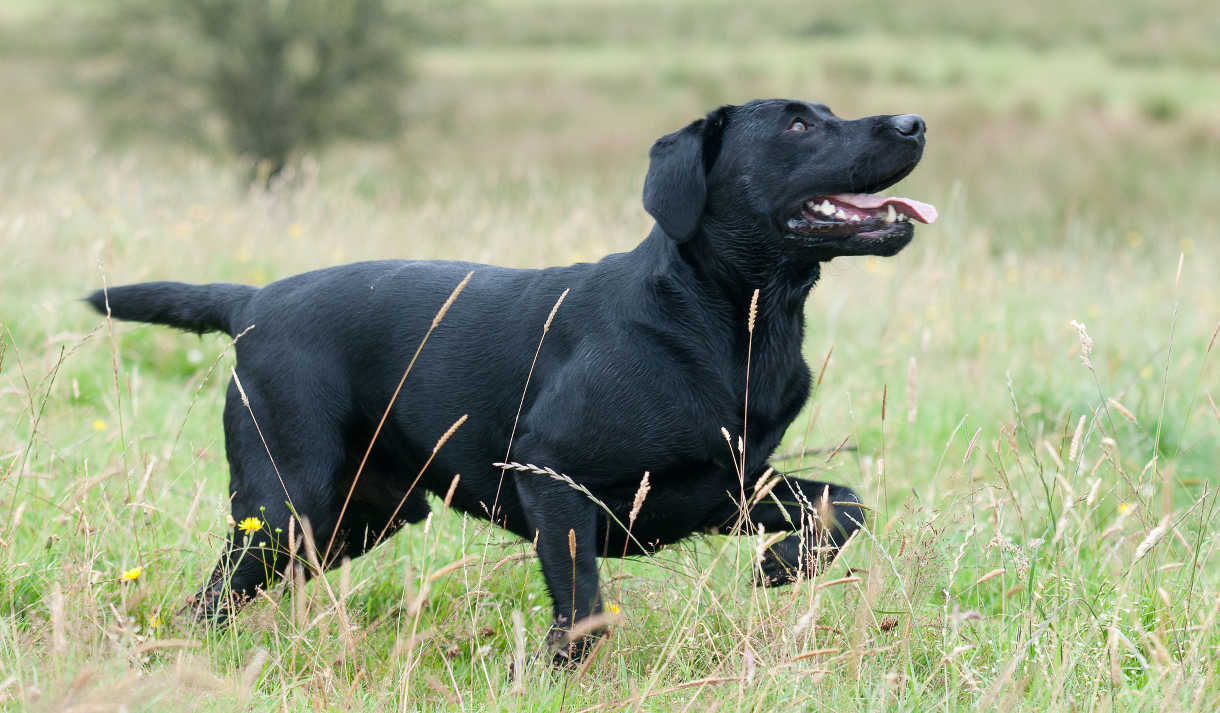
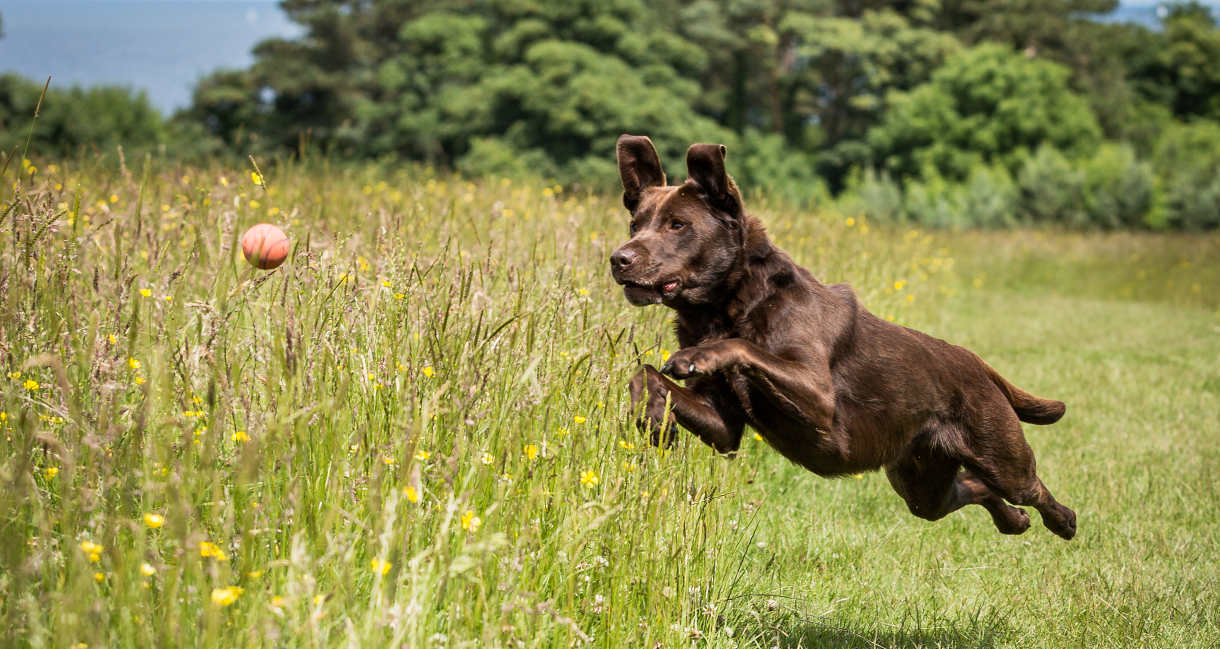
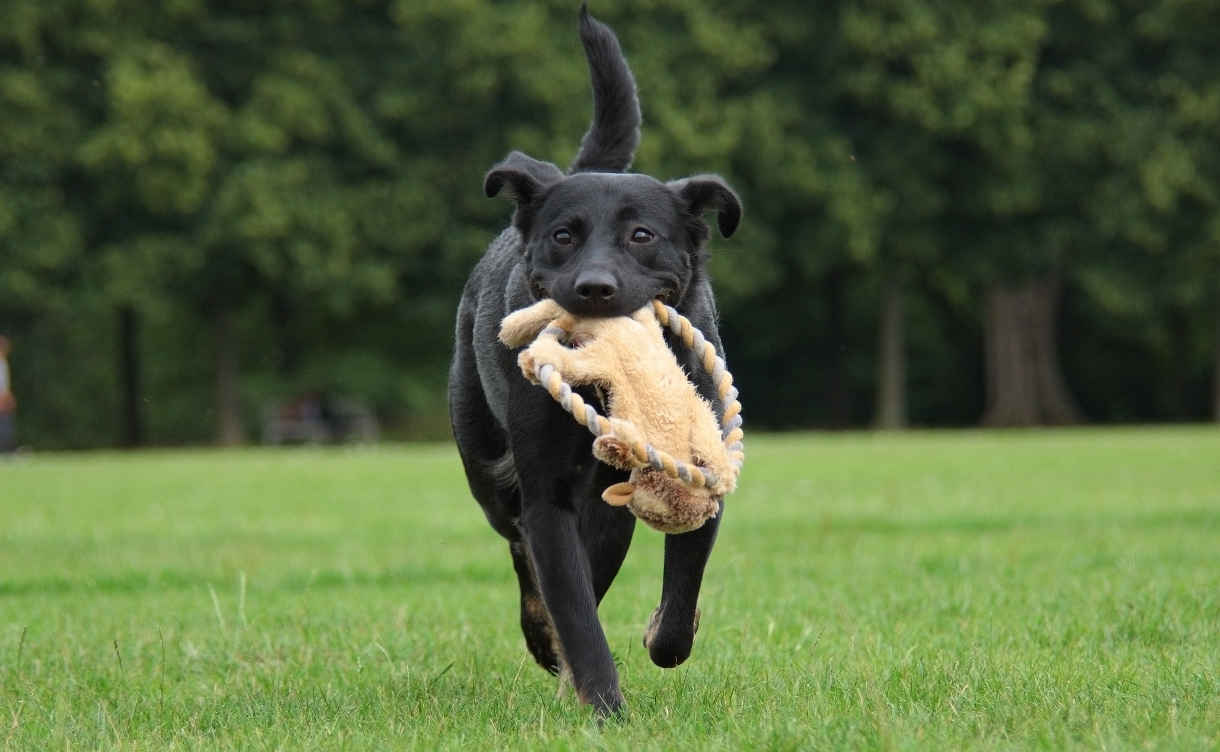
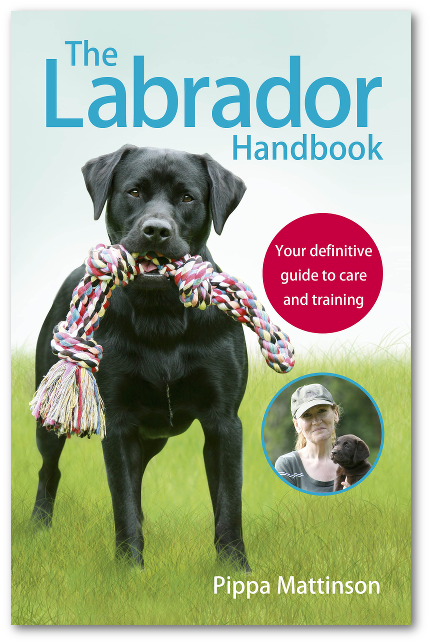




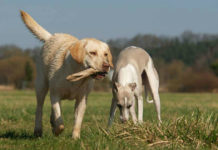











Regarding walking versus running, walking slower engages the muscle for longer than running, but without producing adrenalin, so you should be bringing home a more relaxed dog!
We don’t actually have a lab, but our neighbor does, and I know for a fact the poor boy’s not getting enough exercise. He probably gets under an hour a day (he’s less than 2 years old) Even my Mini Schnauzer gets more than that! Consequently they have issues with him like reactivity, chewing, barking and escaping. I feel so sorry for that boy.
we have just rehomed a 7 1/4 yr old female spayed lab that is slightly overweight and a bit stiff in the front sometimes when walking. She is always super keen to go on walks, jumps low obstacles, always tail wagging and happy. We want to make sure we don’t over walk her but also want to ensure she has fun walks and not just pavement pounding. How long is the maximum she should be walked a day?
Hi. I have a black lab puppy. She is now 9 months old. Walking and training her was a real challenge since she pulled on her leash when walked. I ended up getting a gentle lead from pet smart. It loops around the muzzle and hooks together at the base of the top of the head behind the ears. I can tell you it made all the difference in the world. It instantly stopped the pulling and greatly improved on getting and keeping her attention. Now it’s so much easier to walk and trainer her and at 9 months she’s a wonderful dog and our walks are fabulous!
I have a one year old yellow lab I love him to death but I only am 90 ilbs I try to walk him but he walks me he is so crazy I don’t know what do . I am thinking about finding someone else to take him because I feel so bad I can not control him do to my size I get hurt 3xs a day he is a great dog but is 100 pounds and very strong . He is so smart but very stubborn do you think he will calm down or he knows he is stronger then me and takes advantage of it . He loves me so much I am afraid he will be depressed if I find a new owner for him any advice please help I love him but I don’t know what to do .
I am very familiar with your scenario. This now a year and a half later and I would really like to know how you came through this issue. Could you provide an update please?
i love this website and its info because it helps me alot.
I have a 5 year old lab who was playing slightly rough with another dog and he came of with a slight limp, we have been short lead walking him for 5 weeks and with 2 visits to the Vets. They advised on the 1st visit just to have short lead walks which we have done, after 3 weeks he was still limping I retuned him back to the vet. The vet gave a very thorough overview and he showed no pain at all. He has been given an anti-inflammatory and to continue on short lead walks. Each day he is very differently in terms of the limp, do we look to turn to hydrotherapy . As most labs he is desperate to play ball and run off lead, do you have any advice, No X-rays have been taken at this stage as is soft tissue damage. Thanks michelle
We have a 2 1/2 year old Lab Gorden Setter cross that has up to 6 walks a day about a mile each and off leash runs on the weekend for about an hour each day he kind of decides how he runs for and how long he walks for that suits us
I take my choc lab for a bike ride everyday. I live close to a park with a pond that he loves. https://www.youtube.com/watch?v=dsNx1jd85ZA
Hi All:
My friend probably won’t listen to me since I have never owned a dog because my work does not allow me to meet a dog’s needs for exercise and attention (I have cats) so I am consulting with you about this concern:
My friend is a 68-year old woman with asymptomatic muscular sclerosis. She lost her dog with a lab face a few months ago. A week ago, she finally decided to adopt a 1-year old black lab to join her 13-yr old collie. My friend does not like to go for walks and does not have a fenced-in area for her dogs. She lets them out on a leash for a brief bathroom break and then in again. The collie has gnawed at his legs for years now, is arthritic, but still handsome. I offered to go with my friend to walk the lab, but she said she was afraid the dog’s high energy would cause her to break free and she would be difficult to catch—also that she does not have time in the next few days because she is taking a course and has her private students. My friend told me the dog pulls hard on the leash. “Sounds like a recipe for a broken hip—yours.” I replied.
I realize she misses the dog that died and very much wants this companionship. I worry that my friend will continue her usual cycle of a poor-to-no exercise routine and they’ll both have a poor quality of life for as long as she has the dog. My friend has made up her mind to save this dog she got from a pound (but there are no-kill pounds in our area (Wheeling, WV). But aren’t there other kinds of dogs that would be happy with the routine my friend tends to engage in? What do you think? Thank you for your help.
Susan
Hi I have been reading your comments above and I try to stick to the 5 min rule as often as is I can, only maybe staying out a bit longer on weekends when my lab currently 8 months tends to sit / lie down when she wants to. We have a family holiday planned in August (she will be 11 month and October (13 months) in the Lake District and I was wondering if walking for longer over a short period of time (1 week) will cause any problems, I am trying to look for walks that are relatively flat and not too long, as we usually walk approx 6 miles + a day when we have gone in the past. Any advice would be greatly appreciated as we don’t want to leaver her at home.
Hi i have a 4 1/2 month old lab. He has a lot of energy so recently my husband started taking him on runs with him in the morning. We noticed that one of his paws bleeds during the run. Is he too young to be running? We haven’t taken him on walks, only other exercise he had has been outside playing fetch or we take him to the park and let him run freely. They run mostly on the sidewalk. They take about 15 mins and they run approximately 2 miles. My husband did mention that our dog tried stopping him and dragged his feet for a bit maybe that caused the bleeding? We just don’t want to over-exercise him if he’s not ready. Thanks
Hi Cindy, he is too young for running yet, here is an article about exercising your puppy. https://www.thelabradorsite.com/labrador-puppy-exercise-how-much-is-too-much/
Thank you that article was helpful.
What is the best exercise in pregnancy?
We have a handsome 4 year old coccy lab called chip, he weighs 27kg and instead of walks he runs next to our bikes a distance of between 4 and 6 miles most days on a mixture of Tarmac and off road, with a stop for a swim some days too. We live in a very rural location so I have him off lead in a hi-vis dog vest running next to my bicycle about 10mph on average, he will run to a lefthand side heal on the road sections and where ever he wants when we are off road. We adopted him at 2 years old and the first year just walked him, but now he absolutely loves to run with his pack! I do worry about his joints in the future because of the running and I slow/increase the pace according to him, but generally he just loves it. He has lots of play time in the garden with my 2 boys too. Only issue is food, I feed him in the evenings but he eats his poop sometimes so I worry he has extra food needs?
Hi pippa, please can you advise me weather a 1 hour walk a day for an eleven month old lab at about 10 o’clock every morming is enough excersice for the day. I also think he is a little over weight too, have you any tips.
thanks, dan.
Hi, I am Smruti I have a four months of lab puppy. He is very naughty he use to scatter everything in the house due to this I am now days using chain to stop him doing all this. In evening when I come from office I use to make him walk for 10 mins in whole day ones or twice my kids use to free him and he plays a lot with them he runs very fast in our garage around the car in rooms. This is his exercise he use to do. But one thing he always demand for food whenever anyone of family member eats he use to ask for food n my papa use to give him small portion is this OK or I shud stop that. He also during his walk use to eat all rubbish mud from the road he use to sniff the ground how shud I stop this. What diet shud I follow for a good health and glowing skin of my puppy.
Thank You
Smruti Behera.
Hi
I have a 12 week old chocolate labrador. He is very excite able. We have been taking him out twice a day for an hour each time. Probably only about twenty minutes of actual walking as we are training him. A lot of sitting and laying down etc. having read through the wealth of information I am concerned this could be too much?
Hello,
Currently my dog is 9 months old and health is good, he is so aggressive and some time cool… Regarding exercise – walking not more than 20 / 30 minutes in the whole day. I give him (Veg. pedigree) food 1 times and in the evening another food.
Last some day’s he is facing problem with hair loss and i need suggestion how i control.
Waiting for your important suggestion.
Thanks in Advance
Hi Pippa
I’ve got an 11 month female called Milly, she is the joy of our 6 beautiful children.I take her to the back fields of our house , where i exercise during 30 minutes with a ball. Is it normal that she runs with stopping although i can feel she is breathless? When that happens i decide to take her back home but she wants to carry on.Is it also important a soft pavement for her runs? I just feel she is so happy when running that i don’t wont to spoil it.
Thanks.
Kind regards Julio.
At 11 months Julio, your dog is nearly full grown. Thirty minutes exercise should not be a problem. Pippa
Thanks Pippa,and also im feeding her twice a day at lunch and dinner time 2 medium size full bowls . She only eats mixed dry and can food, don’t you think its too much.
Regards Julio.
hi there i have a 13week old female black lab and just wondering if its ok for her to have a long walk in the mornings proberbly around 3 times a week and its around a two hour allround walk and still take her for a play in the afternoons.
any help and advice would be much appreciated
Hi, I’ve been walking my 5 month old lab for 2kilometers a day. It’s not a straight walk and most times it takes us about 45mins to an hour outside because neighbors often stop and chat with us or cuddle her. She sits beside me and waits patiently. When she was very hyper, I walk her 2-3x a day, and 1 walk is about 2km. Again that 2km usually takes us 45 mins to an hour. The shortest time I walked her was 30 mins. I’ve cut back on walking her because she loves to run and play in our house. Is her exercise too much?
Hi,
I recently took my Aunts 2 Labradors as she has moved overseas for at least 12 months. One is 9 the other is 3. Meg (the 9 year old) has the start of arthritis in her back hip. Our vet advised us she could loose a few kilos, but for her age she is not over weight. She also advised to try and get Meg to keep moving, at least 20mins of exercise a day so her joints don’t seize up. Millie (the 3 year old) is a very anxious girl, my aunt suspects she was born in a puppy farm and this has led to a few behaviour issues and has always been extremely anxious. She has a hatred of anything plastic. She destroys it in seconds! We also have our own dog, a 3 year old Terrier Cross, he thinks it wonderful he has 2 playmates! And they all get along very well. I have found the best way to keep them all happy is to load them into our car and take them to the river. We are lucky to live near a man made beach/sandbar and its a very safe, controlled environment. Meg loves walking in the water, it eases her hip pain I think. And Millie and our little guy love playing in the sand, swimming, leaping and bounding. I try and include them in my own workout while I am there with short sprints and running up and down the stairs. Meg usually goes off and lies on the grass when she has had enough. Which is ok, she joins in when she can. Millie isn’t a fan of stair sets, but she still gives it a go! Its worth noting these 3 are on their own in our yard (which isn’t huge) from 8am-5.15pm Mon to Fri. By taking them to the river for a couple of hours a night has pretty much eliminated all the barking, and most of the destructive, bad behaviour. This style of exercise works for us, and suits our lifestyle. The freedom they have to sniff, dig and roll in the dirt at the river along with the exercise, means they sleep exceptionally well and we are starting to notice Millie is starting to relax and is not as anxious as she has been.
Hi pippa,,,im planning to get a fawn lab soon,,,so ples it wud be great if u cud tell me wt are the diseases a lab puppy has to be kept far from?thank u
Hi Pippa
I have an 8 month old lab and I have religiously stuck to the 5 minute per month that is advised. I currently don’t work so I am able to be with her during the day. However, in a couple of months time my circumstances will be changing and I will be a student. My course is going to be quite demanding (Mon-Fri 9am – 5pm). I don’t really want to leave her on her own for the day with someone coming in for an hour at lunch time to walk her as I don’t feel that’s fair to her. Even though she is crate trained and I know she and the house will be safe, it won’t be much fun for her to be on her own. I have looked into a dog creche for her and she would be there 8am – 6pm. I am slightly worried about her hips as knowing my dog she will be on the go all day every day whilst she is there! Could this increase the risk of hip dysplasia for her? Or would I be better off leaving her at home with a walk at lunch time until she reaches 12 months and then she can go to the creche? Many thanks for your help
Hi Liz, I might be more worried about leaving the dog alone all day for four months, than her hips. Talk to the creche about how they manage exercise sessions, and check with your vet. I cannot tell you that her hips will be OK, but I have seen no evidence to suggest that an 8 month old dog will come to any harm through informal supervised play with other dogs.
Pippa
I have a 9 year old chocolate labrador who used to love his walks each morning&night and sometimes extra walks inbetween times. Recently he has been willing to go out his walks but once we r out he starts pulling on his lead to go back and refusing to walk&sitting/lying down. Can you advise me if this is because of his age. Hes generally became very lazy but still loves his cuddles as hes a big pet.
Thanks
Lynsey
Hi Lynsey, Old dogs in good health still enjoy their walks. There may be due to an underlying medical condition (that is linked to his age), and perhaps causing him pain on walking, so a trip to the vet is in order.
Pippa
Hi, I have a 7 yr old yellow lab and a 3 year old lab cross retriever. They get 2 hours of walking a day, one in the morning and one in the evening. Off lead, in local woods. My 7 year old lab has recently been showing signs of problems with his rear legs/hips. He is happy to go on the walks, but getting up and sitting down – he seems slightly uncomfortable. I’ve started to leave him at home for the second walk, and only take him on the morning one. Can you recommend a supplement? My 3 year old looks really uncomfortable leaving the house without his buddy!
I have almost a 1 year old Labrador/Retriever mix. The last week or so he has been a little strange about his food. He doesn’t like eating out of his bowl lately. He is currently on a puppy chow and I am wondering if he needs to be switched to another choice of food. The weather has been pretty hot and humid in our area so I thought maybe that is why he doesn’t seem interested in his food. He was always eager to eat his food and was pretty much on schedule. The last couple of days his food will sit in bowl for a few hours before he goes to eat. Any ideas!
Hi Karen, dogs may eat a little less in hot weather, but if he is really off his food, a check up with the vet might be a good idea. Most dogs will eat better if you remove any uneaten food after ten minutes. After a few days of this, he will eat when the food is placed down, and you will be in a better position to recognise if he is unwell, rather than just leaving his food for later. Pippa
Hi. I have an 11 month old lab who walks for an hour or so every day (split into two walks), has an hour at the beach in and out of the sea once a week and a longer walk of around 4 1/2 miles once a week. We’re going on a long coastal walk next week and was wondering if it’s ok to take here with us? It’s just over 10 miles. We can stop for breaks and she can have a dip in the sea along the way to cool down. Do you think this is too far for her?
Many thanks.
Hi Kim, a lot of people ask me to tell them it is ‘ok’ to take their young lab on a hike, but unfortunately no-one can say for sure whether a ten mile hike will be too much for your 11 month dog. Until more evidence comes to light, I can’t really add anything to the article I’m afraid. There are so many factors involved, including your dog’s current state of fitness, the structure of her hips, and so on.
Best wishes
Pippa
Hi.
Today we “adopted” a 7-8 year old Black Lab. He is EXTREMELY overweight, around 60kgs. He has been dreadfully neglected. We have always had dogs and have always maintained a healthy weight so it is heart breaking to see the state our newest family member is in. It seems hes only ever been given cheap dry food. Tonight i gave him some chcken wings and he wouldn’t eat them. I also tried him on a little fresh beef but once again, no luck. Should i persist? We are going to start morning walks tomorrow and “game based” excercise in the afternoons. Do you think this is a good start? We will see our vet during the week. We also have a 7kg Cavalier who he is determined to dominate and squash. Unfortunately she is blind and I’m concerned how he will treat her when we’re not here. He’s not showing aggression as he’s constantly wagging his tail, he seems more playful but the cavalier is very unsure. Do you think they will find their place with each other or do you think I should be concerned? Any tips to helping change his lifestyle would be greatly appreciated.
Thank you.
Hi, it is the quantity, not quality of food that makes most dogs fat. And he will be stressed enough having moved home without changing his diet. It might be better to feed him what he is used to for the next week or so, but in MUCH smaller quantities. 🙂 Then once he is settled, change him over to the method of feeding that you prefer. If you decide to make him go ‘cold turkey’ it won’t do an eight year old dog any harm to go a day or two without food. He will eat when he is hungry.
Food quantity is by far the larger influence on weight. Exercise is great and will help to make him fit, but don’t overdue it until he has lost some weight as it may put a strain on his joints. Very small quantities of food is the key. Your vet will be able to advise you in more detail.
You should probably not leave the two dogs alone unsupervised until the lab has settled in and you are confident that he will not bully the Cavalier. Just crate one or the other when you go out, or put them in separate rooms. In the long run they will probably get on fine.
Good luck
Pippa
Hi, I have a 2 year old lab who is great and so loving but im just wondering at this age how much should we be walking him ?, also im not sure how to explain this but since a young age he goes into these moments where he starts spinning around running up and down the kitchen non stop, he could be fine moment playing and been stroked but then snap he goes into doing this, after about 2-3 mins he’s back to his normal self, not really sure why he does this ?
Nicola
Hi Nicola, a two year old lab in good health can be exercised just as much as you want, provided you build up to it, and avoid hard exercise in very hot weather. The crazy moments where the dog races around, even bumping into things, are normal bursts of exuberance, and are more likely to occur if he hasn’t had much exercise that day. Try and give him a good hour’s walk at one end of the day, and at least half an hour at the other. He’ll cope with much more than this if you are up to it 🙂
Pippa
Thank you so much for you advice, when i asked others about this i was getting advised alot of different things and telling me to pay people to come out and stuff, so thank you this was a great help and will be taking him on longer walks 🙂
Hi, I have a 10 week old lab who is perfect in almost every way but, she has just taken up digging and pulling my clothes off the line. She does these things while I am outside with her so I cant be boredom surely..? Do you have any suggestions on how to stop her before this becomes a real problem? Thanks C
Hi Courtney, at this age your best bet is to buy or construct a small puppy playpen that you can put her in when you take her out into the garden. Put it in a place where it doesn’t matter if she digs, and leave her some toys in there to play with that she doesn’t have access to indoors.
Pippa
Hi again, thank you so much for this. And yes with another we would be much more careful…The surgeon said that in a way the fact he was so young(apparently quite a rare case) was a benefit as they seem to recover well and if the convalescence is done properly(like we did) they can be pretty well for the rest of their lives and maybe never have issues again…so we keep our fingers crossed!
Hi Pippa, I have a 2 and half year old chocolate labrador who is to say the list a very excitable one! He now has his very lazy long moments in front of the fire or on the sofa but as soon as someone comes in or wants to play he is off!!He is an entire male simply because we never felt right to castrate him and this we have been told add to his level of energy and excitability but we wouldn’t change him for anyone else!We got him at 8 weeks, didn’t see his parents but had good feed back from other people around us.We used the feed from the owner but after advice change it for a proper large breed one. Weary about weight problems and exercise needs we took him from start to the woods, he loved it and was never scared of older dogs and never seemed tired. The trainer one day told me he was too skinny, took him to the vet and he told me off for the long walks he had so immediately we cut back. At 8 months he started limping, after many trials and error with the vet he was diagnosed with elbow dysplasia and operated at 10 months with excellent results and we had no issues since then. We were told by the surgeon we were unlucky as he seems one you would take as an example of a perfect lab in sizes, body structure etc.He felt the longer walks at the beginning did not help him but that probably he would have had it within himself…and he would have come up with it anyway. A dog as strong and as well built like him even having endured longer walks would have not developed dysplasia unless he would have had it in his DNA. I guess the only way would be to test him and see if he has a faulty DNA or if his dysplasia was the results of too much training and a bad diet in the first 2 to 4 months of his life so more of an injury than a gene problem. Hope this could be of some help for everyone and would like your opinion for my latter doubt. Many thanks for this amazing site!
Hi Concetta, and welcome.
As your vet has said, the dog needs to have the potential for dysplasia for it to develop. Having said that, it is believed that strenuous exercise in puppies may increases the risk of dysplasia developing, given that the genetic potential is there. In other words, it is a combination of genes and environment. Don’t blame yourself for his problems, you did what seemed right at the time, even though you might do differently next time. And your dog probably could not have developed dysplasia without the genetic predisposition to do so.
It is great that his operation was so successful. I hope he continues to stay fit and well.
Best wishes
Pippa
My 3 month Lab pup is very aggressive. He comes in to bite our ankles or will suddenly jump up and bite our arm and at times will draw alittle blood. Can you advise me on how I should handle this issue??? We live in an apartment and he has complete access to the house.
He is exercised once a day for not more than 15 minutes but when we bring him back home, he will poo and pee once again…
My four month lab puppy went out with a friend’s dog, her dog licked dogs’excreta and now my puppy has started doing the same, what can I do to stop this behavour?
Hi there! I have an 12 month old working bred Lab, and recently i have been using an iphone app to see just how far we are walking her, and it seems to average 5-6 miles a day, approx 1-2 hours split over 2 walks on weekdays and 1 big walk at weekends. All walks include on lead and off lead, sometimes swimming, sometimes playing fetch, sometimes playing with other dogs. Is this too much? We tried to keep to the 5mins rule when she was very young, but the last 2 months we have been doing this new routine. She has very good breeding, Sire having 0 hip score. and we do not want to ruin this – and scared that we have??
Hi Rachel
The fact is we just do not know for certain whether excessive exercise can cause problems, the assumption is that dogs will benefit from avoiding hard exercise until their bone growth plates have hardened at between 1 and 2 years of age. This seems a sensible assumption, but it is just an assumption. There is little evidence as yet, apart from a study which showed puppies that did a lot of climbing before three months of age, had a higher risk of hip dysplasia.
How we define ‘hard exercise’ is another subjective question. There are no hard and fast rules, but it might be a good idea to err on the side of caution and avoid very long hikes on your weekends, for a few more months. There is no point in worrying about what is in the past and it may well be that your dog has inherited excellent hips that can cope with everything you throw at him.
There is simply a lot we do not yet know about this subject, but if in doubt, it is probably better to under-exercise rather than over-exercise.
Sorry I cannot be more specific. Do have a chat with your vet for his advice if you are at all concerned.
Pippa
Hello Pippa
We have a 5 year old black lab (Reg) who has had regular walks / swims of an hour or so a day, all his adult life.
We’ve recently employed a dog walker (as my husband will be working away in the future and it is hard for me to give Reg the exercise he is used to with two young children in tow).
Whilst my husband is home he still likes to walk with Reg, but we’re wondering whether increasing Reg’s walks to two, hour long ones a day will be too much for him? (Reg will never say ‘no’ to a walk!)
Your comments will be much appreciated.
Jo
Hi Jo,
Lucky Reg! Many working labradors are exercised for hours at a time. Sometimes several days in a row. An adult labrador is capable of being exercised for hours at a time with certain sensible provisos.
As with people, a sudden increase can cause muscle soreness and even damage. So it is a good idea to build up gradually to any strenuous exercise. Rest days after a long day’s hiking or gundog work can help muscles to rest and repair.
Going from one to two hours (divided into two walks) is most unlikely to harm a healthy adult labrador, but if you have any concerns about your boy’s fitness do drop into your vet for a check up.
Hope that helps
Pippa
Hi, I am thinking of having a puppy. I’m used to labs after losing our family 17yr 1/2 old lab a couple of months ago. I work 3 days a week, my husband is home by 12 noon each day and has two days of a week as he works weekends. My sister will look after the pup whilst I’m at work whilst he is very young with her pup. At what age do you suggest they can be left for 4 hours? or would you suggest a smaller dog with our work situation or no dog at all ( I’m thinking ahead). We have a teenage daughter who will love it like our beloved old georgous boy and it will simulated with play when she is home from school. I Look forward to your comments.
Hi Donna
Sorry to hear you have lost an old friend. 17 is a quite an age for a labrador!
How long to leave a puppy is always a tricky question, and it depends to a certain extent on the dog. Some six month old dogs with good bladder control and a placid temperament will be OK to be left for four hours, but others will not. Especially if they are being ‘re-crated’ after being crated all night.
If the dog has the run of the kitchen, he may be fine, but your kitchen may not. Labradors can be very destructive throughout the first two years if left alone for a long time. Your skirting boards may suffer, and a young dog may revert to messing in the house.
I don’t think the size of the dog is very relevant. Perhaps a compromise would be to pay a dog walker or dog sitter to pop in on him when your sister can no longer help out? At least until he is fully mature and doesn’t need to be crated whilst you are out.
Pippa
Hi, i have a 4 month old lab puppy and absolutely love her. My vet recommended no real excercise until 6 months. She runs around the garden enjoying play time with her brothers and sisters. She couldnt be more happy , growing well, house trained and a pleasure to have. Also very important their diet at this age ! Lots of calcium for normal bone growth. All the best enjoy your pups !
Hi there. As the new owner of two beautiful female black labrador puppies (just 12 weeks old), I’m anxious to get things right, both for us and ‘the girls’. We have started puppy training classes at a reputable local training centre and have been advised (during the first lesson) to use ‘half check’ collars to control pulling. I have always been wary of the ‘choke chain’ device for controlling dogs and would love some advice, please. Do you consider these to be a good idea or is there something else which would be kinder? Many thanks.
Hi Rob, I wouldn’t personally use a half-check collar on a puppy. There isn’t really any need.
What would concern me particularly is, if the trainer is using half check collars at 12 weeks, what other methods are they using? It doesn’t sound terribly positive. 🙁
If you look on the APDT website, you should be able to find a local trainer that uses methods more appropriate for such young pups.
You probably already know that you will need to train the puppies separately to begin with. Good luck with your training
Pippa
Hi Eileen, the problem is we simply do not know for sure.
Not enough research has been done. That is why most vets and breeders recommend you err on the side of caution.
The five minute rule I mentioned above would suggest that your puppy at three months, should not have more than 15 minutes actual walking each day. Whereas your puppy is getting 50 minutes. I would cut down to 15 minutes if it were my puppy, but there is no hard and fast evidence to back up my recommendation.
Playing (especially on a level surface) is a different matter because the pup can stop and start, and is not under pressure to keep going. Sorry I cannot be more specific. It is a subject that is still open to debate.
Pippa
I have a fourteen week Lab puppy. He goes for a walk in the morning about 10 minutes each way and then has a play in the park, another lead walk about 15 minutes each way before his meal. He becomes very active in the evening, we drive to a park and he walk freely and plays with another puppy for about 45 minutes. Is he being over exercised? He sleeps a lot during the day.
We take our two swimming for a change – they adore it, and as well as being good for them physically seems to give mental stimulation too – and gets the dust out of their coats. And I am used to the wet lab smell !!! Plus they always seem to sleep like logs afterwards !
Swimming is brilliant exercise 🙂
Also, just out of interest, what are peolple’s views on giving a glucosamine supplement to Lab puppies to assit joints whilst growing?
I gave my old Lab gloucosamine, the Vet thought that was a good idea and it helped his joints. I think you should get advise from a Vet before giving this to a pup
I have a 5month old lab x springer who, as you can imagine, is full of energy. I regularly take him on long walks but he is not running or fetching during the walk, just plodding along sniffing the ground. Is this OK for him or could it be detrimental to his health? He never looks tired during the walk and rests during most of the day whilst he is at work with me before exercise. We then come home in the evening, wait an hour or so before having his dinner then he goes to bed a few hours later. I’m now worried I could have seriously damaged him but he doesn’t appear to be lame or sore, during or after the walks and seems to throughly enjoy them.
Hi Melanie,
The guidelines in the article are fairly standard nowadays for young pups and I would not recommend long walks for a five month old. Hopefully no harm has been done, but you would not necessarily expect to see lameness at this point even if you were doing some damage. And it is very difficult to tell when a pup this age is tired. He is unlikely to show signs of tiredness when you are walking especially as his muscles are now probably quite fit.
The presumed ‘risk’ is to his skeleton and I would make the walks a bit shorter for a while to be on the safe side. 🙂
Pippa